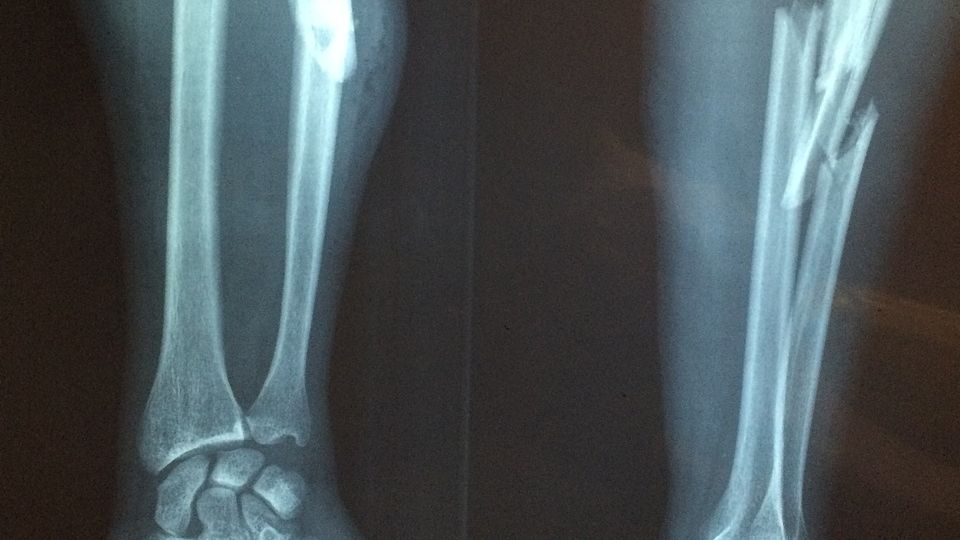
Cast immobilization still has a place in the treatment of long bone fractures. With that said, orthopaedic surgeons today are increasingly inclined to recommend surgery geared at restoring function as soon as possible.
This surgery implies making large incisions for full view of the fracture or smaller incisions for more minimally invasive surgery.
Open reduction internal fixation is the surgical act of making an incision and exposing the fracture. Hardware is then used to stabilize the fracture. Most commonly, the hardware being used is a thin, long, flat metal plate with openings for screws.
Other types of hardware can include long rods that fit inside the hollow portion of the bone. Repairing a fractured bone with these long rods is referred to as intramedullary fixation.
A bone fracture can also be stabilized with an external fixator. These are frames outside of the limb, affixed to the bone with large pins through the skin into the bone.
Join us, today, as we continue our look at bone fracture repair and the Wolf component’s place in this extremely competitive industry.
Fracture Categories
Surgeons qualify a fracture as simple or comminuted, as we have seen. We also categorize fractures as either closed or open. A closed fracture is one with no associated skin wounds. An open fracture is one where the broken bone ends have actually pierced through the skin envelope and have been exposed to the outside the skin. Open fractures are prone to infection especially if they are severely contaminated with dirt and debris.
A surgeon might decide to bone graft a fracture when portions of the bone are missing, as is common in open and comminuted fractures. The source of these grafts is most commonly from the patient’s own iliac crest (the crest of the pelvis) or, increasingly often, bone graft substitutes.
The Technique of Plate Fixing
Fixing fractures with a plate has become one of the most popular techniques used by today’s orthopedic surgeons. Plate fixation allows a surgeon to achieve immediate stability and repair any other associated injuries, starting the rehabilitation process sooner than later.
Patients also benefit from surgery, with greatly reduced fracture pains once the surgeon has stabilized the fracture fragments. Return to function and work are imperative in our modern lives, and this desire has driven great advances in surgical techniques and developments.
Wolf offers surgeons several unique features. Surgeons can install a screw in two very different orientations in a single screw hole, a feature that is unique to Wolf. The surgeon may decide that the fracture fragment is in a direction opposite to one of the possible screw orientations.
In addition to this, Wolf is the first plate to allow the placement of two screws in one single hole. This is in order to create a divergent screw configuration with a much higher resistance to pull out and torsional control. Wolf is also the first plate with numbered holes so that surgeons can utilize minimally invasive techniques and avoid large incisions when the situation permits.
Wolf also allows surgeons to use screws of different diameters, or even smooth screws or pegs. Finally, Wolf comes in different profiles, lengths, and curvatures to address differences in all patients. After all, not all of us are the same. All these features add up to make Wolf the most capable plate available.
Applications
Wolf is completely at home in most fracture situations, including fractures with severe comminution and those with bone loss. It’s also appropriate in challenging situations where the patient may require revision surgery. This can include cases of non-healing fractures and ones healed incorrectly (mal-union). Where bones have to be re-broken and re-aligned to restore function and minimize pain, Wolf is especially useful.
At Toby, we adhere to the belief that the best technology and innovation has to be available to the surgeon. Each patient counts! In addition to this, the competitive prices of our premium devices help to meet the demands for cost containment in Health Care. Cost should not imply a sacrifice in quality and innovation. At least we at Toby don’t think so!
Reach out and get in touch with Toby Orthopaedics for more on the leading orthopaedic implants in the industry, today!

